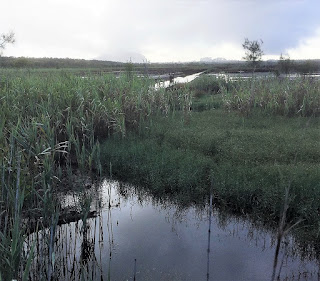 |
| Southern Emu-wren |
This is the fifth post demonstrating changes in the status and distribution of birds in South-East Queensland over 40 years between 1979 – when my booklet, The Birds of South-East Queensland, was published - and 2019. Some changes are doubtlessly influenced by an increased number of observers and technological advances (especially with playback) but many can not be explained by these factors. The list covers only those species where a significant change has been noted over the intervening period. See here for Part 1 (emu to storm-petrels) and here for Part 2 (boobies to hawks); Part 3 (brush-turkey to terns) is here; Part 4 (pigeons to nightjars) can be found here.
Albert's Lyrebird. Described as
“moderately common” and localised in 1979, it is perhaps better
regarded as uncommon today. Its distribution remains unchanged. A
small, isolated population continues to hang on at Mt Tamborine
against expectations. The bird is otherwise restricted to the upland
rainforests of the McPherson and Great Dividing ranges. I commented
in 1979 that there was “considerable evidence” suggesting the
species once occurred in the Blackall Range in the Sunshine Coast
hinterland. There is today a good deal more scepticism about that
evidence. With extensive areas of suitable habitat remaining,
especially in the adjoining Conondale Range, it is difficult to
accept that the species would not still be present, had it occurred
in the region historically.
 |
| White-backed Swallow |
White-backed Swallow. This bird
was “uncommon” in 1979 but known to nest annually in several
places, including along the Brisbane River. Today it could better be
described as a rare visitor; it no longer nests at sites it had been
using for many years.
 |
| Russet-tailed Thrush |
Bassian Thrush & Russet-tailed
Thrush. In 1979 these birds were not recognised as separate
species. Bassian Thrush is an uncommon resident in rainforest and wet
sclerophyll forest in the higher parts of the McPherson and Great
Dividing ranges. Russet-tailed Thrush is a common resident of
rainforest throughout the region but is absent from the higher parts
of the McPherson and Great Dividing ranges; it undertakes some
movement to lowland scrubs in winter. There is a narrow band of
overlap between the two species. Reports of Bassian Thrush from Mt
Glorious in the D'Aguilar Range are contested.
 |
| Hooded Robin |
Hooded Robin. Described as
“uncommon” in 1979 and known from several scattered areas
throughout the region. It appears to have declined, probably due to
destruction of its open woodland habitat, and today could be
considered rare in SEQ except in the Granite Belt, where it is
uncommon.
 |
| Olive Whistler |
Olive Whistler. This species in
1979 was “rare” and confined to the highest parts of the
McPherson Range. That continues to be the case but it clearly has
declined along with several other species that reach their northern
distributional limit in South-East Queensland. While always scarce,
Olive Whistler would once be found reliably during a visit, for
instance, to Mt Bithongabel. That's not the case anymore; years have
gone by without a sighting. While the bird has been recorded in
recent months, its numbers must be perilously low.
 |
| White-eared Monarch |
White-eared Monarch. In 1979 it
was considered “uncommon to rare”. We now know it to be more
numerous than was thought previously. It can be described as
moderately common to uncommon, primarily in lowland rainforest and
vine scrub.
Satin Flycatcher. In 1979 it
was described as an “uncommon” summer visitor. The species in
fact occurs in the region as a scarce transitional visitor during its
annual migration to and from the south-eastern states.
 |
| Shining Flycatcher |
Shining Flycatcher. It was
thought to be “rare” in 1979, with sightings from the Noosa
River, Bribie Island and Fraser Island. It is known now to be a
moderately common to uncommon resident in mangroves as far south of
Pumicestone Passage. It is a scarce visitor south of Bribie Island.
It may be one of several northern species to have extended its range
southwards.
Spotted Quail-thrush. This
species was described as “uncommon” in 1979. It is perhaps better
considered rare these days. While it continues to occupy sites near
Brisbane where it occurred 40 years ago, it has inexplicably vanished
from other places, especially around the Sunshine Coast and
hinterland.
 |
| Spotted Quail-thrush |
Grey-crowned Babbler. Thought
to be “moderately common” in 1979, this is another species that
has suffered a population decline, probably due to destruction of its
open woodland habitat. It could be regarded today generally as
uncommon; it no longer occurs in many of its former haunts.
Superb Fairy-wren. Considered
in 1979 to be “moderately common”, occurring as far north as
Eidsvold. The species has increased in urban areas around Brisbane
and the Gold Coast, where it is common. While the bird occurs
throughout western parts of the region north of Brisbane, it is oddly
absent from the coast and hinterland north of the city.
 |
| Grey-crowned Babbler |
Southern Emu-wren. In 1979 it
was “rare” and known only from the coastal heaths of the Noosa
Plain, Cooloola. That hasn't changed. What has changed is that the
birds are no longer threatened with plans to destroy the heath for
pine plantations, as was the case in 1979; its habitat is now World
Heritage-listed national park. Notwithstanding the presence of plenty
of suitable habitat, the bird has not been recorded elsewhere in
South-East Queensland. A distance of about 400km separates the
Cooloola birds from the nearest population to the south, at Evans
Head in NSW.
 |
| Superb Fairywren |

































